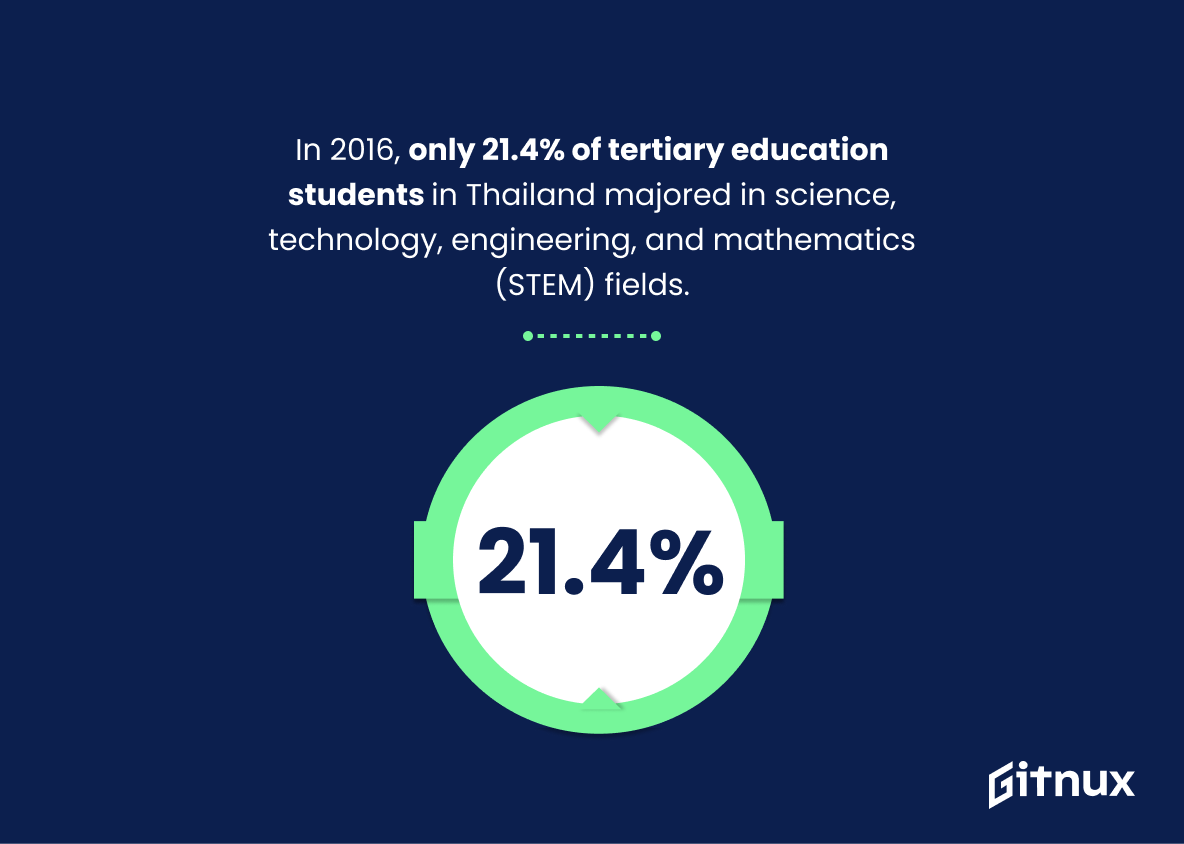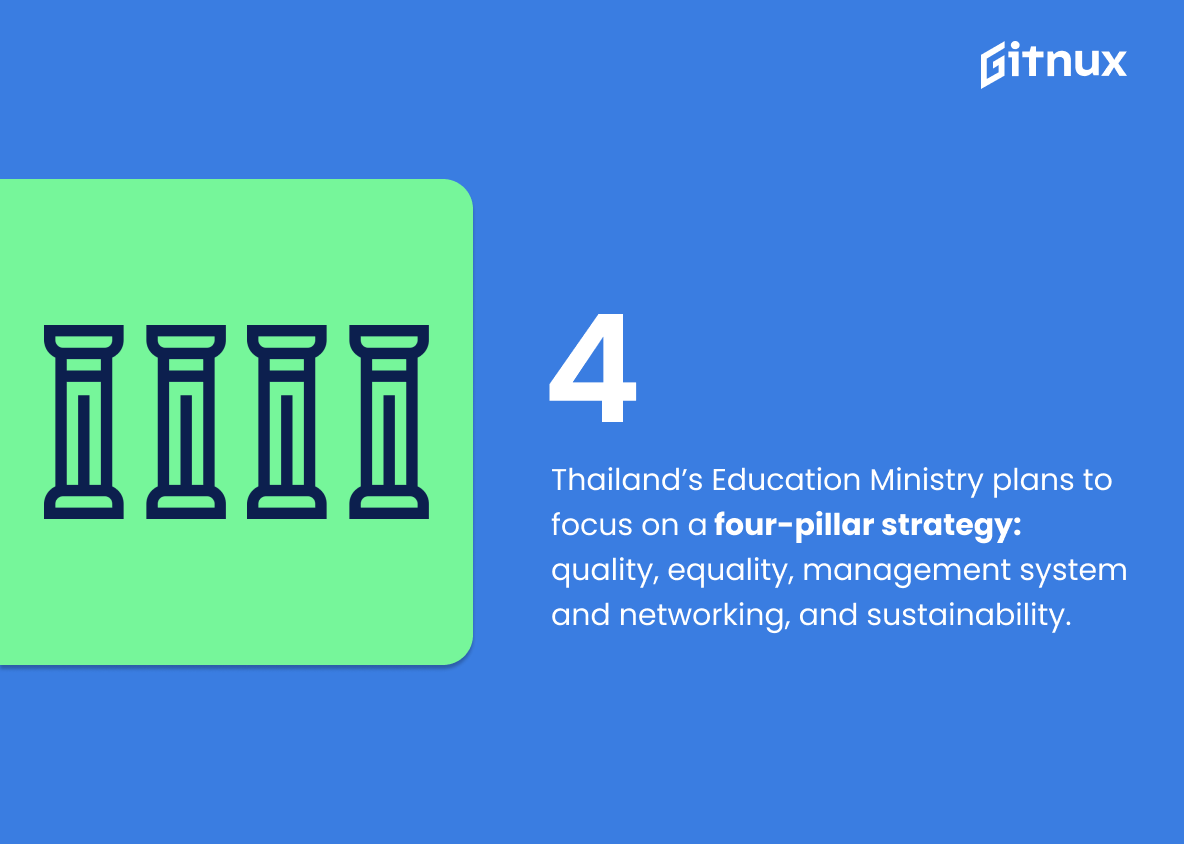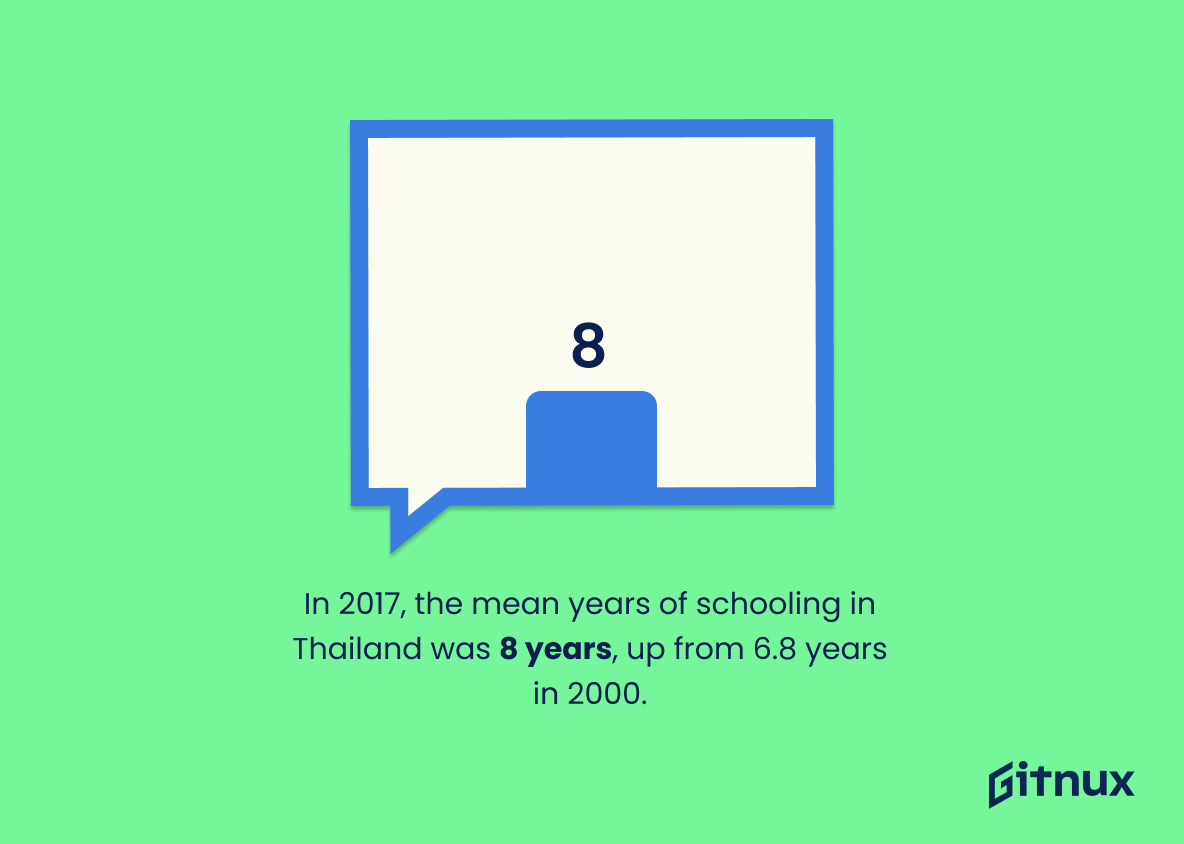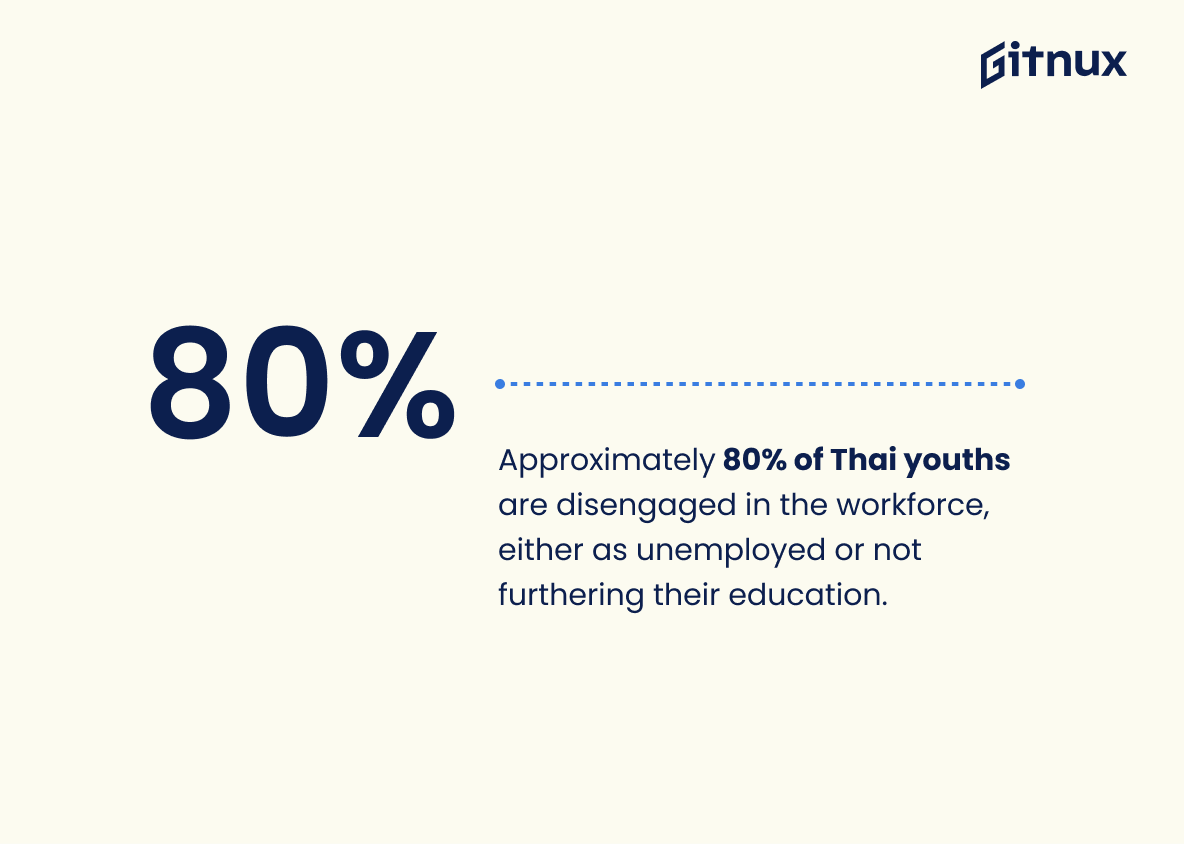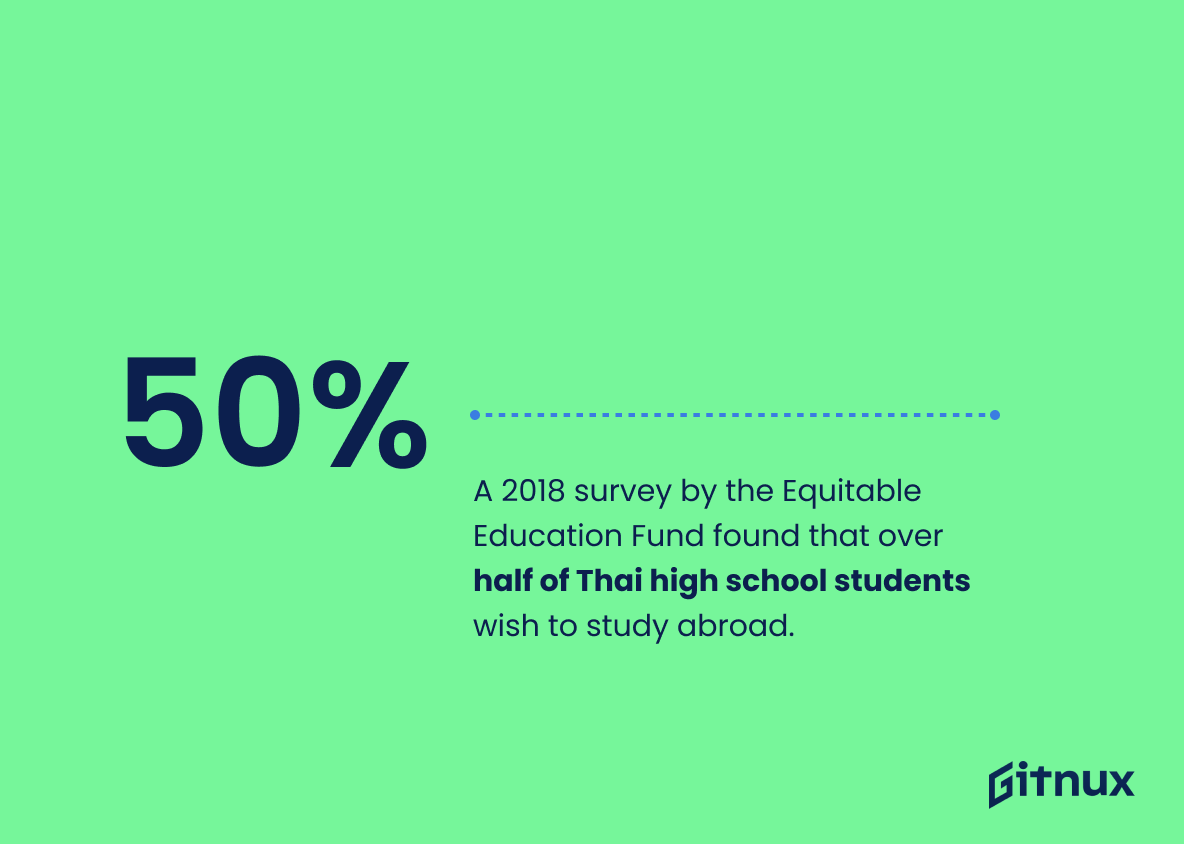Thailand is a country with an impressive education system, and its statistics reflect this. In 2018, Thailand spent 3.93% of its GDP on education and the literacy rate among Thai adults (15+ years) was 92.87%. However, 58% of students below 15 years old did not reach basic proficiency levels in reading that same year. The Global Talent Competitiveness Index 2020 ranked Thailand 88th out of 138 countries while the World Press Freedom Index placed it 102nd out of 176 countries in 2020. Additionally, 480,064 Thai students were enrolled in higher education institutions in 2018 and Thailand ranks second among ASEAN countries for educational attainment according to the 2019 Global Competitiveness Index by WEF (World Economic Forum).
Enrollment rates are high; primary school enrollment reached 99.92% for boys and 99.48% for girls as per UNICEF’s report from 2020 but only 21.4 % tertiary level students majored STEM fields such as science technology engineering or mathematics back in 2016 according to UNESCO data bank reports . Furthermore there are 47 universities both public & private operating within the country today whereas Bangkok has 96 international schools alone making it one of most sought after destinations when it comes to quality schooling options abroad .The government invested 508 billion Baht(approx 16 billion USD )in Education sector during current fiscal year which shows their commitment towards improving overall standards across all age groups .However ,a survey conducted by Equitable Education Fund revealed that over half Thai High School Students wish study abroad due to lack opportunities available at home along with low performance scores amongst 15-year olds where 64 percent scored lower than expected results math tests set OECD standard guidelines 2017 . This could be attributed fact 80 percent youths remain disengaged workforce either unemployed or not furthering their studies leading average spending 83 thousand bahts student each academic session despite gender gap still exists between male female enrolment ratio 53:23 respectively engineering courses specifically
In conclusion ,the Government’s four pillar strategy focusing Quality Equality Management System Networking Sustainability should help bridge gaps existing within various sectors improve overall learning outcomes future generations come
This statistic is a telling indication of the importance that Thailand places on education. By allocating 3.93% of its GDP to education, Thailand is demonstrating its commitment to providing its citizens with the resources and opportunities necessary to pursue their educational goals. This statistic is a powerful reminder of the value that Thailand places on education and its potential to shape the future of the country.
The literacy rate among Thai adults (15+ years) was 92.87% in 2018.
The literacy rate among Thai adults is a crucial statistic when it comes to understanding the state of education in Thailand. It provides a snapshot of the country’s educational progress and highlights the need for further investment in education. This statistic is a testament to the hard work of Thai educators and students, and serves as a reminder of the importance of continuing to strive for educational excellence.
Thai Education Statistics Overview
Thailand ranked 88th among 138 countries in the Global Talent Competitiveness Index 2020.
This statistic is a telling indication of the state of Thailand’s education system. It suggests that the country is lagging behind in terms of its ability to attract and retain talented individuals, which could have a negative impact on its economic growth and development. By highlighting this statistic, the blog post can draw attention to the need for Thailand to invest in its education system in order to ensure that it can compete on a global level.
Thailand ranks 102 out of 176 countries in the 2020 World Press Freedom Index.
The 2020 World Press Freedom Index paints a concerning picture for Thailand, as its ranking of 102 out of 176 countries indicates a lack of freedom of expression and press. This is an important factor to consider when discussing Thai education statistics, as it could mean that the public is not receiving the full picture of the state of education in the country. Without a free press, the public may not be aware of the successes and challenges of the education system, and thus unable to make informed decisions about the future of education in Thailand.
A 2018 survey by the Equitable Education Fund found that over half of Thai high school students wish to study abroad.
This statistic is a telling indication of the state of Thai education. It suggests that many Thai high school students are not satisfied with the education they are receiving in their home country and are looking for better opportunities abroad. This highlights the need for improvement in the Thai education system, and could be used to inform policy decisions and investments in the sector.
In 2017, 64.8% of 15-year-old Thai students were low performers in mathematics.
This statistic is a stark reminder of the need for improvement in the Thai education system. It highlights the fact that a large proportion of 15-year-old students are not achieving the expected level of proficiency in mathematics, which could have a long-term impact on their future prospects. It is a worrying sign that the current system is not adequately preparing students for the challenges of the modern world.
In 2016, only 21.4% of tertiary education students in Thailand majored in science, technology, engineering, and mathematics (STEM) fields.
This statistic is a telling indication of the state of STEM education in Thailand. It suggests that the majority of tertiary education students are not pursuing STEM fields, which could have a long-term impact on the country’s ability to compete in the global economy. This statistic is a reminder that Thailand needs to invest more in STEM education to ensure that its students are equipped with the skills and knowledge necessary to succeed in the 21st century.
In 2019, Thailand’s Education Ministry plans to focus on a four-pillar strategy; quality, equality, management system and networking, and sustainability.
This statistic is a crucial indicator of the Thai Education Ministry’s commitment to improving the quality of education in the country. It highlights the importance of four key areas – quality, equality, management system and networking, and sustainability – that the Ministry is focusing on in order to ensure that all students have access to a quality education. By understanding the Ministry’s strategy, we can gain insight into the current state of Thai education and the steps being taken to improve it.
In 2017, the mean years of schooling in Thailand was 8 years, up from 6.8 years in 2000.
This statistic is a testament to the progress Thailand has made in the realm of education. It shows that the country has made significant strides in the past two decades, increasing the average years of schooling by 1.2 years. This is a positive sign that Thailand is investing in its future generations and is committed to providing quality education to its citizens.
Approximately 80% of Thai youths are disengaged in the workforce, either as unemployed or not furthering their education.
This statistic is a stark reminder of the importance of education in Thailand. It highlights the need for more educational opportunities and resources to be made available to Thai youths, so that they can gain the skills and knowledge necessary to become engaged in the workforce. It also serves as a warning that without proper education, many Thai youths may be left behind in the global economy.
Approximately 53% of Thai higher education students are females, but only 23% of engineering students are females.
This statistic is a telling indication of the gender disparity in the field of engineering in Thailand. It highlights the need for more initiatives to be taken to encourage female students to pursue engineering, and to create an environment that is conducive to their success in the field.
Conclusion
From the statistics presented, it is clear that Thailand has made significant investments in its education system. The literacy rate among Thai adults (15+ years) was 92.87% in 2018 and enrollment in primary education reached 99.92% for boys and 99.48% for girls by 2020, indicating a high level of access to basic educational opportunities across the country. However, there are still areas where improvement can be seen; only 21.4% of tertiary students majoring in STEM fields and 64.8 % of 15-year-old Thai students were low performers in mathematics according to 2017 data respectively show room for growth when it comes to quality of learning outcomes as well as technical skills development amongst young people within Thailand’s borders . Additionally, with 80 percent youth disengagement from either employment or further study also being reported , more needs to be done towards providing meaningful pathways into work or higher studies after completing secondary school levels . Overall though , these figures demonstrate that while progress has been made over recent decades , there remains much potential yet untapped when it comes to improving both access and quality standards within Thailand’s educational landscape going forward .
References
0. – https://www.data.worldbank.org
1. – https://www.knowledge.wharton.upenn.edu
2. – https://www.ourworldindata.org
3. – https://www.bangkokpost.com
4. – https://www.univisits.com
5. – https://www.gtcistudy.com
6. – https://www.gpseducation.oecd.org
7. – https://www.rsf.org
8. – https://www.researchgate.net
9. – https://www.databank.worldbank.org



